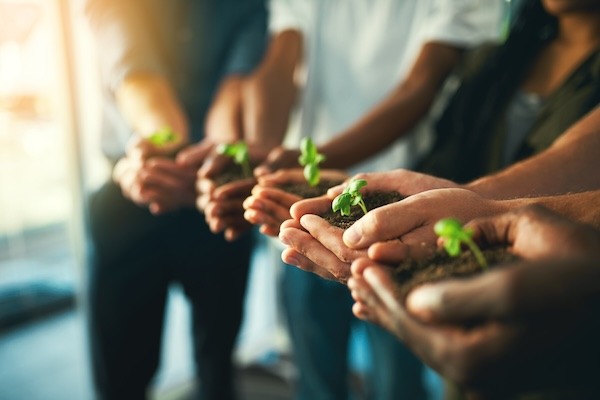Published on
Mirroring Modern Learners: Moving Beyond Silos by Crafting Community-Centric Partnerships

When I first stepped into higher education, coming from industry and K-12, I was charged with building an online learning program for professional audiences. This was my thing—I could do this: program development, digital learning, pedagogical innovation. To my surprise, however, institutional roadblocks extended and expanded at every step, whether it was accessing data, purchasing new tools, or connecting across disciplines. I found that, while most stakeholders wanted to collaborate, itched for innovation and celebrated new approaches, they were all hindered by either unalterable processes, impassive territories or mentalities that left them feeling defeated. (Give me a nod if this sounds familiar.)
All stakeholders, from leadership to instructors to staff to learners, deeply feel the frustrating effects of silos within higher education institutions. Regardless of institutional strategic goals such as boosting enrollment, broadening diversity and equity efforts, and increasing student academic success, silos often hinder progress (EAB, 2022). The ingrained nature of institutional silos (schools, divisions, etc.) makes cross-silo planning arduous and prone to failure, which stifles innovation and further entrenches the status quo.
The results often neglect what our modern learners really need: innovation, personalization and community. What approach then should we take to tackle the silo problem to foster innovation and serve our modern learners? It’s more concrete than we may think: build community-centric partnerships, beginning with our internal communities before expanding outward. Community-centric partnerships are collaborative relationships between programs and communities, emphasizing mutual respect, shared decision-making and active community engagement to address needs and foster positive outcomes.
Schools can use the same best practices that support modern learners—experiential experiences, emotive support, creation spaces and personalized approaches—to build community-centric partnerships and incubate innovation at the intersection of seemingly separate entities. Leveraging the science of learning can go a long way, and we don’t have to be in learner-facing positions to reap the benefits of knowing how people learn best.
For decades, educators have been adopting and adapting David Kolb’s model for experiential learning, finding ways to foster student learning by doing. Recent pedagogical research builds on Kolb’s initial theories, recognizing that “deliberately generating emotional engagement with students through classroom-based experiential pedagogy can result in transformative learning outcomes that change a student’s perspective and behavior in lasting and positive ways” (Dean et al., 2020).
The truth is the classroom is not the only place an experiential approach can be effective, and students are not the only constituents who benefit from such an approach. If we apply an experiential model to our partnerships across the institution, shared spaces with shared purposes become the norm. And we can begin to deliberately build community-centric partnerships that have long-lasting impacts on our relationships within the institution and on our learners.
At Bentley University, one key partnership is between executive and professional education and the innovation center, called The Badavas Center for Innovation in Teaching and Learning. Like many universities, one of Bentley’s strategic priorities is to build executive and professional education as a revenue generator but also as an authentic service that provides today’s learners with durable skills and lifelong networks.
It must then include an interdisciplinary portfolio, where expert instructors and industry leaders across disciplines and divisions not only collaborate but build pedagogically innovative learning experiences to equip today’s learners with skills to navigate a fast-changing world. Simply asking instructors for this collaboration, however, is not enough; they need opportunities for ideation, spaces to connect on a human level, tools to spark creativity and guidance on pedagogy. They must contribute their expertise like skilled chefs crafting a rich meal, blending diverse elements together to create a transformative experience, rather than merely contributing to a potluck dinner.
There is an emotional component to creating these opportunities for instructors that cannot be ignored and must be prioritized. Just as students need to “feel that they belong to their community … find emotional, social, and cognitive support for one another … to engage in dialogue and reflection more actively and take ownership and responsibility of their own learning” (Baker 2017), so do instructors, so do we all!
In fact, much of our response data from instructors includes an emotive response such as “I gained confidence and clarity on how to design new curricula, all while feeling supported”; “I feel as though this … has been one of the most dynamic [years] for me because of the collaborations I have had”; “My experience in this process has truly been inspiring, motivating and fun!” Emotions drive change, so if we can create emotionally nurturing partnerships, we can foster growth and innovation.
Coupling the emotional component with a process ensures transparency and prioritization. In the executive and professional education program development process at Bentley, our Badavas Center for Innovation in Teaching and Learning is step two of seven: scope (initial conversations), ideate (innovation session), register (details and final scope), revise (fine-tune innovations), webinar (sneak peek for learners), launch (program begins) and debrief (evaluation). By intentionally putting the innovation center at the beginning of the process, it situates the learner’s experience as the center of the program, while prioritizing the instructors’ experience in an interdisciplinary space.
Take our recent Developing Leaders for Global Sustainability program as an example, where instructors from four departments and two divisions ideated in the innovation center together with a pedagogical expert and a market-oriented executive education leader: Economics, Management, Natural and Applied Sciences, and Information Design and Corporate Communication. A quick glance looked like this: instructors contributing to a mapping activity on a wall of whiteboard paint, creating shared objectives and discussing market insights.
With markers and post-its in hand, they’re drawing lines from an active learning strategy to a problem-based deliverable. They’re discussing how to teach a case study together, so learners can identify and visualize the connections and multiple perspectives; they’re playing with personalized learning options, ensuring every learner leaves the program with a tangible action plan.
Faculty member Dr. David Szymanski captured the impact well: “The wicked problems of sustainability don’t follow the rules of academic silos, and we shouldn’t either. Working across these imaginary boundaries helps us teach, learn, and develop a more robust community of problem solvers.” It is the moment when a meal truly comes together, not piece by piece but as a whole new culinary experience.
It sounds idyllic, but it is also possible, as I have seen firsthand. By prioritizing experiential spaces that foster interdisciplinary ideation, incubation and human connection, by intentionally building such partnerships into processes, by utilizing the learning science within the institution and for the modern learner, silos suddenly become more malleable.
References
Baker, J. (2017). Updating the Next Generation Digital Learning Environment for Better Student Learning Outcomes.
Dean, K. L., Wright, S. & Forray, J. M. (2020). Experiential Learning and the Moral Duty of Business Schools. Academy of Management Learning & Education, 19(4), 569–583. https://doi.org/10.5465/amle.2018.0335
EAB. (2022). Five Threats of Silos Briefing [PDF file]. Retrieved from https://attachment.eab.com/wp-content/uploads/2022/01/PDF-PASF-EAB-Five-Threats-of-Silos-Briefing.pdf


